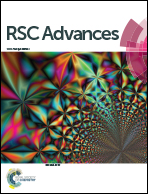Site-specific functionalization with amino, guanidinium, and imidazolyl groups enabling the activation of 10–23 DNAzyme†
Abstract
10–23 DNAzyme has been extensively explored as a therapeutic and biotechnological tool, as well as in DNA computing. Faster cleavage or transformation is always needed. The present research displays a rational modification approach for a more efficient DNAzyme. In the catalytic core, amino, guanidinium and imidazolyl groups were introduced for its chemical activation through the adenine base. Among the six adenine residues, A9 is the unique residue that realizes all the positive effects; the 6-amino and 8-position of adenine and the 7-position of 8-aza-7-deaza-adenine could be used for the introduction of the functional groups. A12 is a new choice for catalytic improvement with an 8-substituent. Therefore, more active DNAzymes could be expected by this nucleobase-modified activation approach.



 Please wait while we load your content...
Please wait while we load your content...